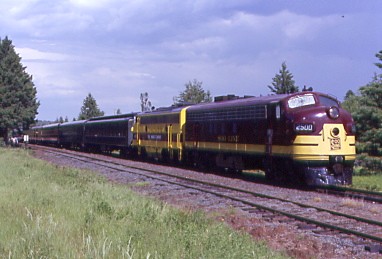
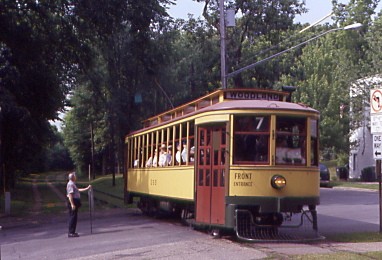
Bob Riskie and I were up early at 6:00 AM, so it was indeed a short night, then enjoyed a fair breakfast, missing those of the last few mornings. We walked the three blocks over to the Hilton Hotel to pick up our 2004 NRHS convention packets and tickets we would need for our trip then took the items back to the Best Western before returning to the bus loading location for the drive north to Duluth. The buses arrived late at 8:00 AM, with Bob and I boarding the second bus which departed at 8:24 AM. On the way out of town, we passed the former Milwaukee Road station with trainshed, now a Courtyard by Marriott, which used to be served by the Milwaukee Road, Soo Line and Rock Island.
Once on Interstate 35W, when we crossed the Mississippi River, we saw the former railroad Stone Arch bridge, now a bicycle path. Bob and I spent the bus ride chatting with Gary Kazin and Dan Chazin. Dan also writes for Trainweb and has a very interesting website. All the buses made a rest stop at the Kettle River Rest Area, which put a strain on the men's restroom. From there, we continued to Duluth and after giving us a scenic tour of the city, the driver finally found the museum parking lot.
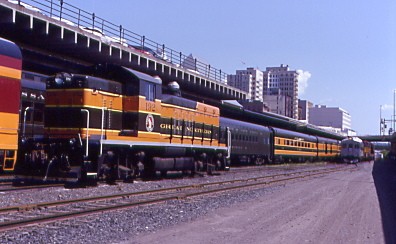
We arrived at the Lake Superior Transportation Museum and I went outside to photograph North Shore Scenic RDC 9169, Great Northern NW-5 192, DM&IR SD18 193 and the two F-units that would pull our charter train today. After watching some switching, I returned to this outstanding museum and it was then time to board our train. Two lines of people trying to get into one line to pick up their boxed lunches created a delay. We finally boarded and at 12:37 PM, were off for Two Harbors and Bob and I sat with Jim Bergant from Louisville, Kentucky, whom I had met at the 2001 convention.
Our train was reversed the half mile out to the junction with the mainline, since when the freeway was built, that eliminated all eastward movements out of Duluth Union Station. Our train had Erie Mining F9A 4211, Soo Line FP7 2500A, Great Northern dining car 1250 "Lake of the Isles", Great Northern power-baggage-concession 1000, Great Northern coach 1115 "Liz Prebich", Duluth, Missabe & Northern business car "Missabe" and Duluth and Iron Range coach 33.
We ran along the freeway and after the waterfront activities, paralleled Lake Superior with a view of the breakwater then passed the Korean War Monument before Lakeview Park with its rose garden of more than 250 varieties of roses. We cut inland through some neighbourhoods and forests before crossing Lester River on a 150 foot long and 45 foot high bridge then crossed Highway 61. The train ran at a good speed through the forest with the highway to the left before it left us then we crossed the trestle over French River at MP 13 and later Big Sucker Creek at Palmers (MP 16.0), followed by Little Sucker River.
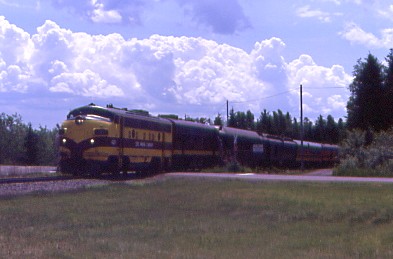
Knife River, MP 19.0, was the scene of a photo runby with the Duluth, Missabe and Iron Range depot still standing; this is the reverse move.
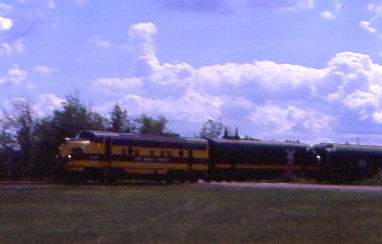
I switched locations for the photo runby. Everyone reboarded and crossed Knife River just before it flows into Lake Superior then passed the siding at Marbles, MP 25, the furthest north I had been on this railroad and started new trackage from this point on. We crossed under the Dululth, Missabe and Iron Range tracks to the ore docks at Two Harbors then went under another DM&IR line.
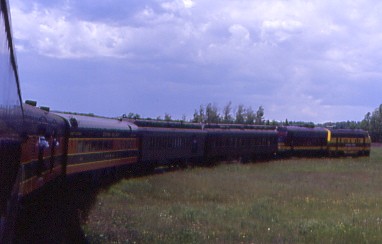
Our train reversed into the Two Harbors station at 2:20 PM as the sky began to look stormy. I toured the museum which houses a nice collection of area history before going into town for some chocolate chip cookies.
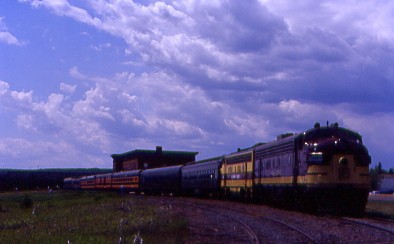
The excursion train at Two Harbors, MP 27.0, before I rested onboard until departure time.

We reversed out of the station at 3:18 PM as the rain started and poured. After the downpour, we proceeded to Palmer where a photo runby occurred in brilliant sunshine just after the rain stopped and it was one of the best diesel runbys I had seen. Hats off to the North Shore Scenic for such an excellent excursion and runbys. With the SOO Line locomotive leading, we all enjoyed its air horn as it blew for all the crossings on the way back and great conversations were had by all. We arrived to a sunny Duluth which had been rained on during our absence and reversed into Duluth Union Station at 5:04 PM, ending a very interesting convention excursion on the North Shore Scenic Railroad. A special thanks to their crew for a very special trip.
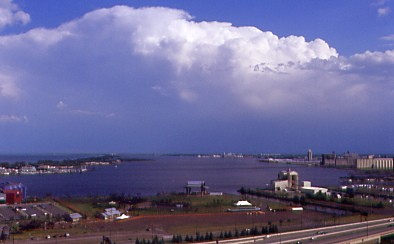
John Jensen of Louisville joined Bob and I as we walked one block to the Duluth Radisson and went up to the Revolving Roof Restaurant for a nice dinner where I enjoyed a T-Bone steak. What a great view this eating establishment gave us. We returned to get our bus back to Minneapolis and John left on the one at 6:00 PM with Bob and I on the 6:15 PM bus. I listened to music on the way back and above Hinckley, we passed through a light rainshower then stopped at the General Anderson Rest Area to break up the trip, returning to the Hilton at 9:00 PM and walked back to the Best Western for the night.
Hiawatha Light Rail Line Part 1 7/1/2004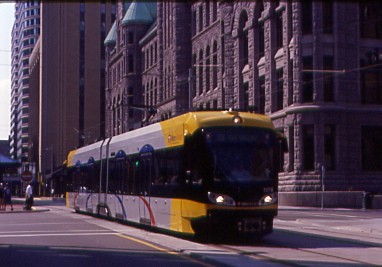
This Dominion Day, I was up early and had breakfast before walking over to 5th Avenue for my first ride on the brand-new Hiawatha light rail line. I rode north from the Government Plaza station to the Warehouse District, which is near the Target Center then travelled down 5th Avenue to the Nicollet Mall station and onto the Warehouse/Hennepin Avenue station before returneding where I started. I found a Kinko's to check my e-mail then found a National Camera for film later in the day.
Minnesota Transportation Museum Visit 7/1/2004Bob and I walked over to the Hilton for the convention's Transportation Museum visit, departing on time aboard the bus which crossed the abandoned Milwaukee Road line to the West Coast then we ran west to Lake Calhoun where I had my first view of the streetcar line we came here to ride.
Como Harriet Streetcar Line 7/1/2004The Como-Harriet Streetcar Line is a heritage streetcar line which follows original streetcar right-of-way between Lake Harriet and Bde Maka Ska and is operated by the Minnesota Streetcar Museum. The heritage line was originally developed in the 1970's by the Minnesota Transportation Museum. When Twin City Rapid Transit ceased streetcar operations in 1954, it donated two of its locally-built wooden streetcars to railfan groups. One of the groups receiving a streetcar (No. 1300) was the Minnesota Railfans Association, which organized railfan trips from the 1940's to the 1960's. TCRT 1300 was stored outside until it was acquired by the Minnesota Transportation Museum in 1962, when restoration began. By 1963, the car had been restored to operational status. It originally made only short trips along track at and near a roundhouse in St. Paul owned by the Minnesota Transfer Railway. Because there were no overhead electric lines at this location, the streetcar was powered by an electric generator behind the car. Despite these challenges, the car was extremely popular with the public.
Since public interest was so high, the museum examined options for regular operation of 1300. The City of Minneapolis and the Minneapolis Park and Recreation Board had acquired the original streetcar right-of-way between Lake Harriet and Lakewood Cemetery near Lake Calhoun (now known as Bde Maka Ska) and in 1970, the Minnesota Transportation Museum leased the land. On August 28, 1971, after track had been laid and a small carbarn constructed under the Queen Avenue Bridge, which passed over the original right-of-way, public operations began. Because no overhead wires had been strung to provide electricity, the trailer-mounted electrical generator continued to be used until the overhead electrical system was completed in 1973.
Continued popularity of the heritage line allowed the museum to expand from about one city block of track in 1971 to more than one mile of track. Over time more streetcars were acquired and restored by the museum. Three streetcars are operated on the Como-Harriet line, although only one or two are run at any given time. The line is listed on the National Register of Historic Places. The original streetcar station at Linden Hills was built one block north of the intersection of Queen Ave and 42nd Street in 1900. As time progressed, TCRT desired to make Lake Harriet an entertainment destination in an effort to increase recreational ridership. At this time, the company built the original Lake Harriet Bandshell and began sponsoring concerts at the lake. Because of the larger crowds being drawn to the attraction, there was a need for a larger station, and in 1914 a larger chalet-style structure replaced the original building, which was moved closer to the lake and used for other purposes. The chalet station existed until 1954 when streetcar operations ceased, at which time it was torn down.
By the time the Minnesota Transportation Museum began construction of the heritage line, all that remained was the concrete slab used as a platform for loading and unloading passengers. In 1990, the museum built a recreation of the smaller original Linden Hills Station. Today, the station is used for purchasing tokens to ride the streetcars, souvenir sales and the display of Twin City Lines history.
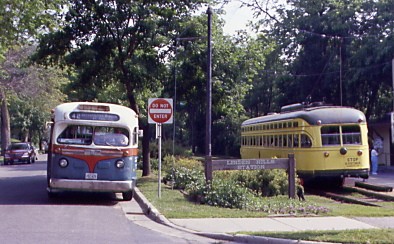
The museum's vintage 1954 bus delivered us to the Linden Hills depot where half the group boarded the first car.

The rest of us waited for Minnesota Transportation Museum PCC car 322, ex. Greater Cleveland Regional Transit Authority 3 1977-1990, exx. Transport of New Jersey 3 1971-1977, exxx. Public Service Coordinated Transport 3 1953-1971, nee Twin City Rapid Transit 322 1946-1953 built by St. Louis Car Company in 1946.
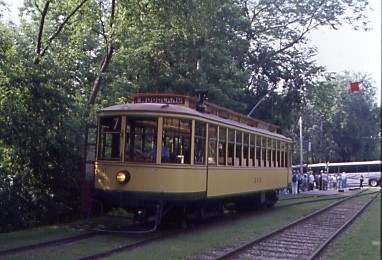
We reversed along the tree-lined grade to the shop building where half the passengers detrained.
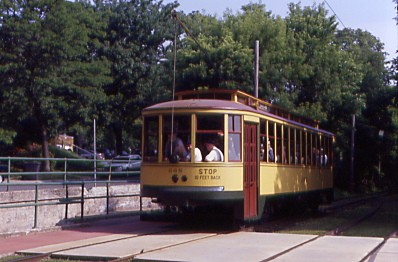
We went into the passing siding track where we met Minnesota Transportation Museum 265, 1973-present, ex. Duluth Street Railway streetcar 265 1916-1939, nee Twin City Rapid Transit 1791 1915-1916, built by the company in 1915. After being retired, it became a summer cabin then was saved and restored in 1982. We then passed underneath an arched bridge with a last look at Lake Harriet before seeing Lake Calhoun and passing Lakewood Cemetery at the end of the line.
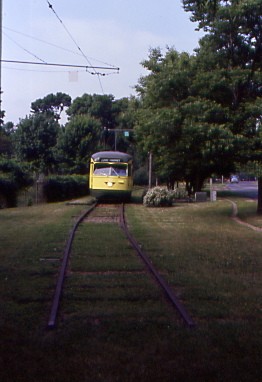
At the passing track, we met 1300 again before we continuing to the shops and dropped off a few more members. I returned to the Linden Hills depot and visited the gift shop.

Next came Duluth Street Railway 265 from the shops and I walked down to the lake and found a restroom before boarding the bus for the journey to St. Paul.
Jackson Street Roundhouse 7/1/2004The Jackson Street Roundhouse was built in 1907 and was one of the last roundhouses built by the "Empire Builder", James J. Hill. It replaced a smaller wooden engine-house of Saint Paul & Pacific. The Roundhouse was part of a large shop complex built in the 1880s. Located near downtown Saint Paul just north and east of the State Capitol, the complex had been sold by Great Northern in 1960. The Roundhouse was then remodelled as a warehouse/industrial building. All the tracks were removed and an addition was built where the turntable used to be.
MTM took possession of the Roundhouse in 1986, acquiring a substantial mortgage. Jackson Street was restored as an operating roundhouse, but with several changes. It is MTM’s back shop, but it also houses exhibitions, archives, an audio-visual theater, a meeting room and offices. The turntable was re-installed in 2001, and the connection with the current day BNSF was restored along with five yard tracks. BNSF cleaned up the environmental pollution which was mostly petroleum in the groundwater. The large mortgage was paid off through the generous financial support of longtime director Arthur E. Pew III and others.
The Museum at Jackson Street Roundhouse opened in 1999. In March of that year, MTM hired its first paid Executive Director and the administrative offices moved into a renovated space, shared with the Great Northern and Northern Pacific Historical Societies. They and MTM are creating an archive with climate-controlled space and a combined cataloging system.
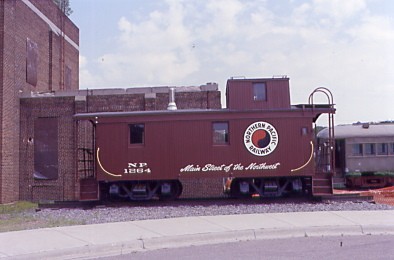
Upon arrival, I was greeted by Northern Pacific caboose 1264, nee Northern Pacific 1144 built by South Baltimore Car Works in 1901 and was on the railroad's roster for sixty-eight years, wearing the "Main Street of the Northwest" brown paint scheme. When this car was retired in 1969, it was the oldest caboose still in service on the railroad.
Around 1901-1902, the Northern Pacific was experiencing a severe shortage of cabooses. This was in part due to an unusual number of accidents involving cabooses. Sixteen were destroyed in 1900 and twenty-two in 1901. As a result, the Northern Pacific purchased several batches of new cabooses in 1901 and 1902 and 1144 was one of thirty 26-foot long cabooses produced there that year for the Northern Pacific Railway. They were constructed with wood bodies and wood underframes. When delivered to the railroad, these cars carried road numbers 1139 through 1168. The purchase price of No. 1144 in 1901 was $994.76.
Caboose 1144 apparently spent most of its life on the west end of the Northern Pacific. As of October 1920, it was at Pasco, Washington. In May 1939, 1144 was in service on the railroad's Idaho Division which had its headquarters at Spokane, Washington. The Idaho Division handled trains between Paradise, Montana and Yakima, Washington. The division's major yard and service facilities were at Parkwater, just east of Spokane. In July 1939, 1144 was sent to the railroad's shops at South Tacoma for a complete rebuilding. The car's body was shortened to 24 feet from its original 26-foot length. In addition, a steel underframe was applied, replacing the original wooden one. The caboose then returned to service on the Idaho Division.
Still based at Parkwater, the caboose was renumbered 1264 in May 1942, the third instance of that number on the railroad. Upon retirement, it was listed as "dismantled" as of July 29, 1969. Reportedly, it was donated to a retired employee that year. After passing through several owners, the wood body of this caboose was eventually acquired by the Minnesota Transportation Museum. Somewhere along the line, the number of the car was mistakenly changed to 1294 and it carried this number for some years.
In the recent past, caboose 1264 has been located at the Minnesota Transportation Museum's Jackson Street Roundhouse where it served as an office for the supervisor of renovation work at the roundhouse. Subsequently the car was moved to the east side of the roundhouse to make room for major renovation work on the west side of the building. In 2000, the Minnesota Transportation Museum undertook major reconstruction of 1264 to replace timbers and siding which had decayed. During the process of rebuilding, workers discovered the caboose's correct number, 1264, stamped into some of its window frames. Such a stamping of a car number was a common practice at railroad shops so that parts from different cars would not get mixed up.
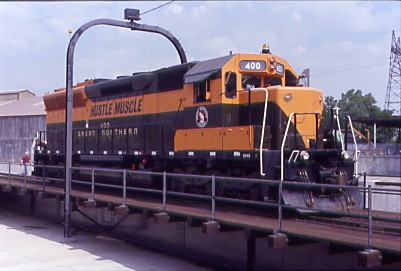
I immediately walked out to the turntable finding the Great Northern SD45 400 "Hustle Muscle", built by Electro-Motive Division in 1966 as the first SD45.

Inside the restoration shop was Minnesota Transportation Museum 4-6-2 2153 2002, ex. City of Grand Forks 2153, nee Northern Pacific 4-6-2 2153 built by Baldwin in 1909.
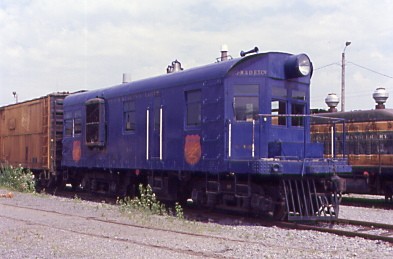
Minnesota, St. Paul, Rochester & Dubuque Election Traction Company (Dan Patch Electric Lines) boxcab gas-electric 100, built by General Electric in 1913 and claimed to be the first internal-combustion freight locomotive constructed in the United States. Later acquired by the Minneapolis, Anokn & Cayuna Range Railroad, the engine was repowered in 1957 with a Waukesha diesel engine. When the MA&CR was acquired by the Great Northern in 1966, 100, still operable, was donated to the MTM. Over the years, the unit was repainted into its original blue livery, and rebuilt by the museum for excursions with Northern Pacific 328. 100 operated occasionally into the 1980's, but due to its limited power, has been in storage for the past decade.
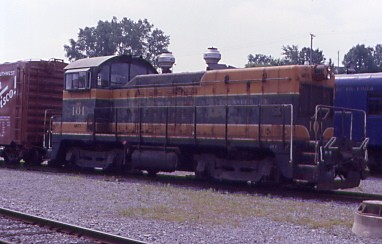
Lake Superior Terminal Transfer NW2 101 built by Electro-Motive Division in 1948. The Lake Superior Terminal & Transfer Railroad, full corporate name, the Lake Superior Terminal & Transfer Railway of the State of Wisconsin operated about two dozen miles of trackage entirely within the City of Superior from the 1880's to the 1980's. It never went to Duluth. Through most of its existence and into "modern" post-war times, it performed three principal functions.
Firstly, it performed terminal and switching services for its four owners in Superior: the Great Northern, Nothern Pacific, Chicago, St. Paul, Minneapolis and Omaha, and Duluth, South Shore and Atlantic. Much of this involved transferring cars to and from the non-owning railroads in the area, Soo, DWP and Milwaukee Road. Secondly, it operated as a joint-facility for its owning railroads to serve and switch many of the customers along Superior's waterfront. These were principally grain elevators (including Farmer's Union, claimed to be the world's tallest elevator) along the Tower Bay line; and coal and other bulk docks in the area where the Ortran Coal Terminal now is and in Superior's North End. In recent years, LST&T also had the honor of switching the car ferry dock, loading and unloading the Incan Superior from Thunder Bay. Thirdly, it wned and operated the Union Depot in Superior which was used by GN and NP passenger trains and later Amtrak. The company offices were here also.
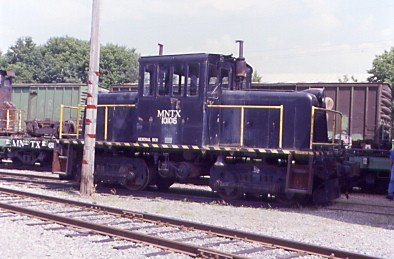
Minnesota Transportation Museum 45 ton switcher 10106, nee United States Navy 7251 built by General Electric in 1942.
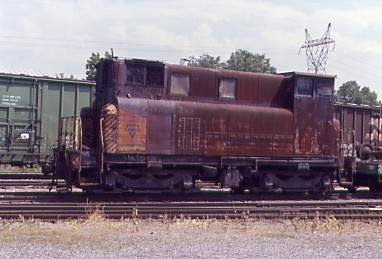
ARMCO Steel Company steel cab switcher B-71 built by Baldwin-Westinghouse in 1930. It was used at their Butler, Pennsylvania steel mill then went to Michigan Railway Historical Society and later to the Cadillac & Lake City Railroad. It last operated in 1973 and was moved to St. Paul around 1985.
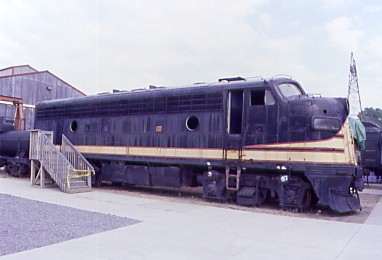
Burlington Northern F7A 668, nee Great Northern F7A 454A built by Electro-Motive Division in 1950. It was the first unit of a matched A-B-B-A set (454A, 454B, 454C, 454D) built for freight service. It was completely overhauled at Burlington Northern's Dale Street shops in St. Paul in January 1976, at which time it received the BN Cascade Green paint scheme and snowplow pilot. Prior to rebuilding, this locomotive 668 had been the last F-unit in the original Great Northern paint scheme. The Dale Street shops were closed in June 1976 and Burlington Northern 668 was retired in March 1981.
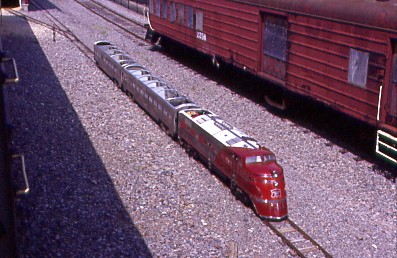
The three inch gauge Rock Island miniature train at the museum. In the car shop was Northern Pacific 4-6-0 328 in pieces and inside the roundhouse was a nice collection of passenger cars. I then was able to ride "Hustle Muscle" for two-tenths of a mile out along the BNSF mainline, after which I rode a Fairmont motorcar out just a bit further. All in all, the Jackson Street Roundhouse is an excellent museum that gives you the experience of what Twin Cities railroading once was. I talked with Gary in the fresh air with a nice cooling breeze before the bus picked us up to take us back to the Hilton, ending another very enjoyable convention day.
Hiawatha Light Rail Line 2 7/1/2004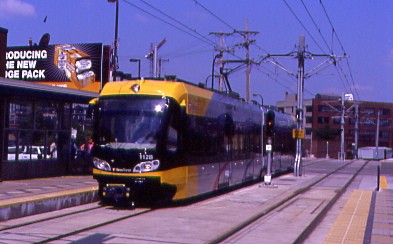
Bob and I first walked to National Camera so I could get more film then proceeded to the Hiawatha Light Rail line.

On the way there we found a bronze statue honouring Mary Tyler Moore, the beloved actress who played Mary Richards, a young single television producer for a Minneapolis news station. Though the show was a sitcom, it took a head-on, modern approach to women's liberation. The opening sequence ends with a freeze frame of Mary tossing her hat into the air, on the very downtown corner where the statue was erected in 2002.
Bob and I boarded the first car that came along with Bob off to ride the whole line. I, on the other hand was going to a baseball game and detrained at the Metrodome.
Chicago White Sox vs the Minnesota Twins 7/1/2004
I arrived at the top of the sixth with the White Sox leading 2-1. Carlos Lee hit a two-run home run in the top of the first and the Twins scored one in the bottom of the first inning. I bought a hot dog and Coca-Cola before finding a Lower Pavilion seat out in centerfield. A child, named Tyler, who was celebrating his fifth birthday, correctly guessed today's attendance at 21,127. With two outs in the ninth, the Twins' Michael Cuddyer doubled but Joe Mauer struck out to end the game. Even though I had not been able to attend for the whole game, I was glad to finally have been able to be at the Metrodome.
Stone Arch Bridge 7/1/2004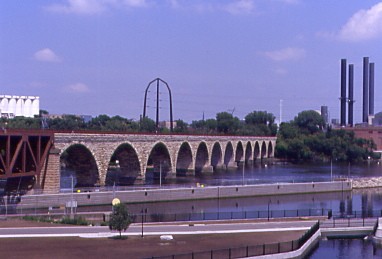

After the game was over, I knew the first four trolleys would be standing room only, so I decided to walk across the Stone Arch bridge, built by railroad baron James J. Hill in 1883. It allowed for increased movement of people and goods across the river and was the route of the Empire Builder and North Coast Limited, among others until 1978. Rehabilitation of this National Historic Engineering Landmark began in 1980 and the bridge is now a walking, bicycle and transit bridge and is on the National Register of Historic Structures. After photographing it from the west side, I walked across the bridge over the Mississippi River to a park on the east side to relax.
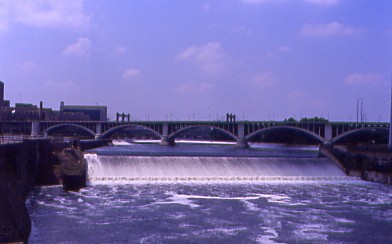
Upper St Anthony Falls and the locks are seen from the bridge. About 10,000 years ago, the great River Warren Falls, with its massive erosive powers, moved upstream until it reached the junction of the Mississippi and Minnesota Rivers. There it split into two separate falls, and the one that followed the Mississippi River course became St. Anthony Falls (to the Dakota it was called mnirara (curling waters) or owahmenah (falling waters). Father Hennepin gave the falls its current name in 1680 being the first European to view the falls.
During the 1700's and 1800's, explorers and settlers visited the region to see the great spectacle caused by the falls. The falls became the main source of power for the many lumber and flour mills that were built around the area during this time period. St. Anthony Falls suffered severe damage from 1860 to 1887 due to overuse and poor engineering of water power systems. The US Army Corps of Engineers made improvements to the falls in 1937 to help stabilize the falls.
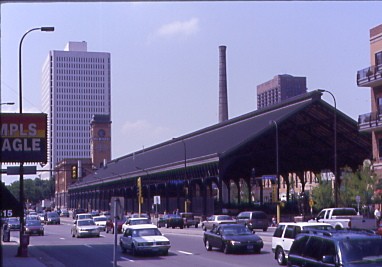
On my way back to the light rail I saw the former Milwaukee Road station built in 1898.
Hiawatha Light Rail Line 3 7/1/2004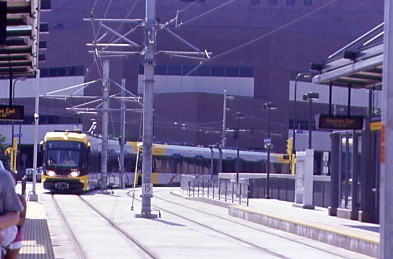
I boarded a standing-room train as the Light Rail tour from the convention was aboard, as well as more baseball fans mixed in with the regular riders. We passed the Metrodome to our right and curved to the Cedar/Riverside stop then ran underneath Interstate 94 passed the Light Rail shops and just south of there was Franklin Avenue station. A bicycle lane joined our route as we reached 52 MPH, climbed a grade to bridge Highway 54, which we followed south then dropped back to the ground, only to climb again to the elevated Lake Street/Midtown station with a great view looking back to downtown Minneapolis.
South of here were interesting buildings to the east, namely the ACME Company in a large brick building and I wondered if this was the company that cartoon characters mailed to order items to help them? The large Secure Mint storage was followed by the Archer-Daniels-Midland Milling Company. We passed EZ Storage before the 38th Street station, another ADM Milling Company elevator then a Harvest State Grain elevator before passing through a short tunnel to 50th Street/Minnehaha station. Here we left Highway 55 as we climbed to cross Hiawatha Avenue and a future highway with our last glimpse of downtown. The route dropped and curved into a residential area before the VA Medical Center station and from there, we made our way to the last stop at Fort Snelling with the 133rd Airlift Wing of the Minnesota National Guard located here. This is the present end of the Hiawatha Light Rail line at 7.7 miles. In December, the line will open to the airport and the Mall of America. Here we all detrained while the trolley pulled down to switch ends before I returned downtown to the Government Plaza station, where I detrained.
I returned to the hotel, then Bob and I went to McCormick and Schmicks where I had fish and chips with plenty of sourdough bread. After walking a portion of the Skywalk, we returned to the hotel to watch some of "Unforgiven" as I rested before my last NRHS convention activity.
Night Photo Shoot 7/1/2004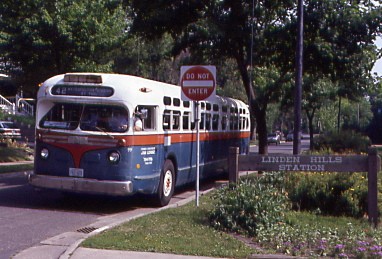
I boarded Minnesota Transportation Museum vintage bus 1145 built by General Motors Truck and Coach Division in 1953 and departed at 9:30 PM. On the way out of town, we passed a newer model bus with me saying to a passenger aboard it, "Our bus is older than your bus!", which garnered a round of laughs from our passengers. We made our way back to the Jackson Street Roundhouse and "Hustle Muscle" was on the turntable so we photographed it from two different angles. Next, Dan Patch Line 100 was lit up for the fifty photographers present, followed by Lake Superior and Transfer NW-2 with Frisco box cars. The final scene was a triple photo location with three tenders partially out of the roundhouse. It was a unique photographic experience to be a part of and this was my last convention event. Hats off to the Northstar Chapter for hosting this year's convention. We returned to the Hilton at 12:35 AM and I quickly walked back to the Best Western for my last night there.
I am very sorry but none of my night photo pictures could be scanned due to the darkness of them.
| RETURN TO THE MAIN PAGE |